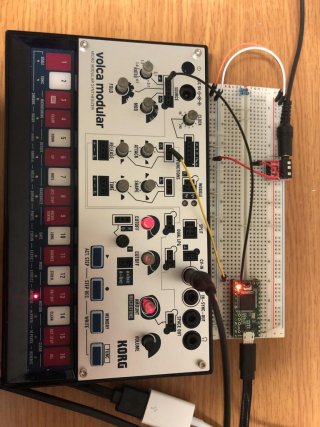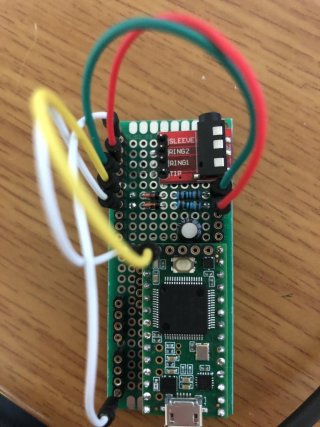jidagraphy
Active member
Short version :
Generating DC voltage from the teensy board and connecting it directly to a 3.3v modular system (Volca Modular) *SEEMS* to work - literally just a jumper cable to a CV input of the external system, without any ground provided. But why does it work? and is it okay to use it like this?
Long version :
Hey.
So I've got a Korg Volca Modular. It's just a cute toy instrument version of a modular system, that uses jumper cables and operates in 3.3v. So I thought - Teensy is 3.3v, so why not connect my teensy onto the volca and I can control it better?
My initial thoughts were to just connect my teensy's output voltage to the volca via jumper cables but then I realised I can't just output voltages from a system to another without ground, and expect it to work. But I did. And it worked. At least the Gate CVs - haven't tested out Pitch CVs yet.
From what I understand, how we measure voltage is the *difference* between one end and the ground right? And thus normal Eurorack patch cable would have CV tip and Ground ring.
But what I'm doing is literally just connecting a pin on the teensy to a pin on the volca and its working. Weird thing is, when I operate the volca on 6AA battery instead of a power adaptor, it stops working. But it worked again when I tried plugging in an 'empty' CV-in cable to the volca, that sends nothing but has ground connected to my teensy. So I *think* it's a ground issue but I still dont understand why it works when my volca is connected on a power adaptor, and if I shouldn't be doing this lol.
Can anyone clarify what's going on?
A working version of the system.
Teensy 3.2
Pin 13 into Volca's ADSR GATE
Pin A14 into Volca's pitch
An empty 3.5mm cable that only has ground connection of the teensy.

Generating DC voltage from the teensy board and connecting it directly to a 3.3v modular system (Volca Modular) *SEEMS* to work - literally just a jumper cable to a CV input of the external system, without any ground provided. But why does it work? and is it okay to use it like this?
Long version :
Hey.
So I've got a Korg Volca Modular. It's just a cute toy instrument version of a modular system, that uses jumper cables and operates in 3.3v. So I thought - Teensy is 3.3v, so why not connect my teensy onto the volca and I can control it better?
My initial thoughts were to just connect my teensy's output voltage to the volca via jumper cables but then I realised I can't just output voltages from a system to another without ground, and expect it to work. But I did. And it worked. At least the Gate CVs - haven't tested out Pitch CVs yet.
From what I understand, how we measure voltage is the *difference* between one end and the ground right? And thus normal Eurorack patch cable would have CV tip and Ground ring.
But what I'm doing is literally just connecting a pin on the teensy to a pin on the volca and its working. Weird thing is, when I operate the volca on 6AA battery instead of a power adaptor, it stops working. But it worked again when I tried plugging in an 'empty' CV-in cable to the volca, that sends nothing but has ground connected to my teensy. So I *think* it's a ground issue but I still dont understand why it works when my volca is connected on a power adaptor, and if I shouldn't be doing this lol.
Can anyone clarify what's going on?
A working version of the system.
Teensy 3.2
Pin 13 into Volca's ADSR GATE
Pin A14 into Volca's pitch
An empty 3.5mm cable that only has ground connection of the teensy.



